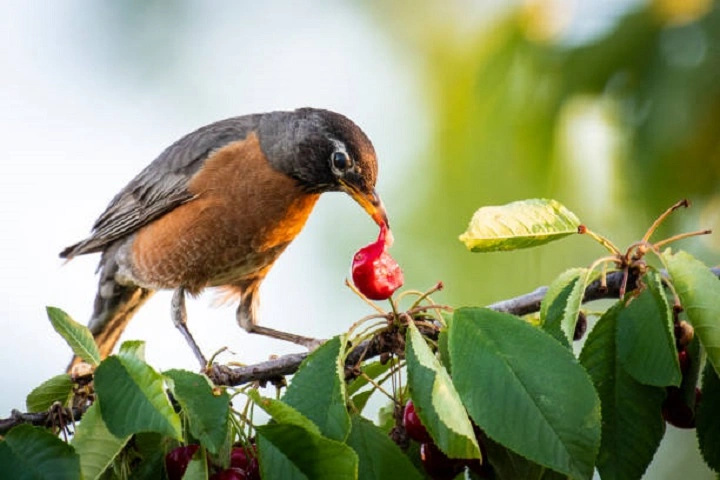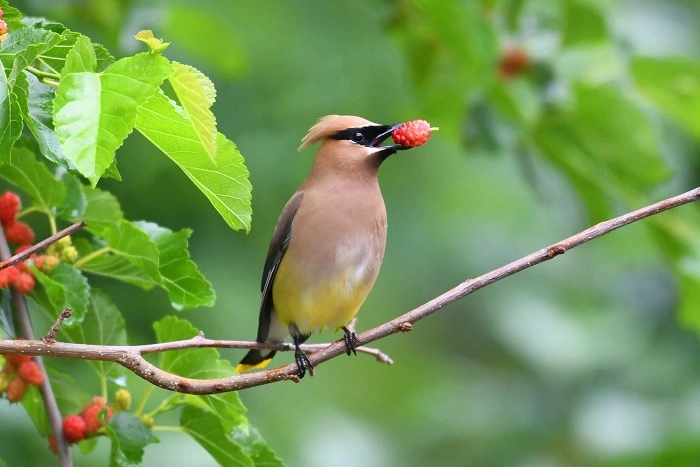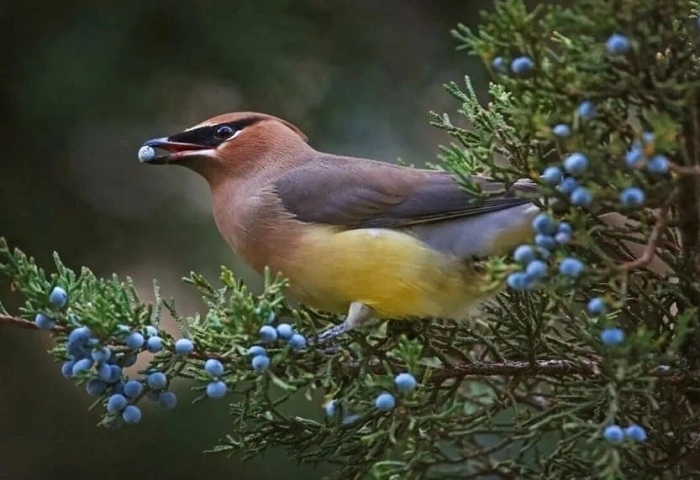A berry bush in the garden. Red jewels in sunlight. Suddenly, wings flash by. A robin swoops down, nibbles, swallows, and disappears.
Yes, birds eat fruit. But not all birds. Not all fruits. And not always in the ways we might dream of.
Fruit is the sweetest in the world. Birds are its messengers. When the beak touches the berry, something magical happens—energy is transferred, seeds are transplanted, forests are reborn. In this book, we will explore which birds eat fruit, what fruits they prefer to eat, what fruits to avoid, and how you can feed them at home.
By the end, you’ll see fruit not just as food, but as a bridge—between tree and wing, between your yard and the wild.
Why Birds Eat Fruit
Fruit is fuel wrapped in color.
- Sugars: Instant energy for flight.
- Vitamins: Keep feathers shining, bodies strong.
- Water: Juicy fruit hydrates in summer heat.
- Seeds: Birds don’t just eat. They scatter. Every drop becomes tomorrow’s forest.
Fruit is barter. Birds take food. Trees get gardeners.
Which Birds Eat Fruit?
Not all birds love fruit. Some of them are bug hunters. Some are predators. But many love fruit as part of their diet.
Songbirds
Vibrant, bold, musical.
- Orioles
- Tanagers
- Thrushes
- Robins
Parrots and Parakeets
Rainbow-colored rainforest friends.
- Macaws
- Conures
- Cockatiels (in moderation)
- Budgerigars
Tropical Specialists
Masters of the rainforest smorgasbord.
- Toucans
- Hornbills
- Fruit doves
- Turacos
Well-Known Backyard Visitors
They raid gardens and orchards.
- Blackbirds
- Starlings
- Jays
- Mockingbirds
All have their place. All disperse seeds as payment.
Fruits Birds Frequently Eat
Berries
Nature candy. Small, colorful, impossible to overlook.
- Blueberries
- Raspberries
- Blackberries
- Elderberries
- Mulberries
Orchard Fruits
Sweet, seasonal, often half-eaten under trees.
- Apples
- Cherries
- Pears
- Plums
- Peaches
Tropical Treats
Favorite of parrots and imported birds.
- Mango
- Papaya
- Guava
- Bananas
- Figs
Citrus Fruits (limited amounts)
Tart, juicy, thirst-quenching.
- Oranges
- Tangerines
- Clementines
- Grapefruit
Melons and Vines
Hidden hydrations behind sweetness.
- Watermelon
- Cantaloupe
- Grapes
Fruit is seasonally available, but birds keep track like a calendar.
Fruits Birds Should Not Eat
All in the fruit department is not safe. Some are more toxic than nutritious.
- Avocado: Persin, toxic to parrots.
- Apple seeds and cherry pits: Release cyanide compounds. The flesh is okay—stay away from the cores.
- Unripe persimmons: Cause upset digestion.
- Overdose of citrus: Too acidic if eaten daily.
- Processed fruit: In cans, sugared up and dried, or in syrup—never safe.
The rule? Ripe, fresh, seedless. Always.
Indications Birds Eat Fruit in Your Area
Want to know if fruit’s on the menu? Watch for signs.
- Ground apples with pecks taken out of them.
- Berries eaten down to a halt and still on the tree branch.
- Purple or red poop on perches.
- Birds buzzing around fruit trees early and late.
Nature leaves clues if you know where to look.
How to Feed Fruits to Birds at Home
Fresh and Simple
- Apple slices on a tray feeder.
- Orange halves on sticks.
- Berries or grapes in shallow dishes.
Safety First
- Wash fruit thoroughly. Pesticide-free.
- Cut into bite sizes.
- Pit and seed removal.
- Rotate daily to avoid spoilage.
Variety Wins
Offer fruits with seeds, nuts, or suet. Birds prefer balance, not sugar.
Red Flags: Feeding Faux Pas to Avoid
Loving birds is about protecting them. Watch out for these faux pas:
- Moldy fruit: Spoils rapidly, is poisonous.
- Sweet foods: Jam, jellies, candies—horrible.
- Excessive citrus: Eats the stomach.
- Overripe mush outside: Better bird repellents than seed magnets.
- Plastic net on fruit feeders: Dangerous to feet and beaks.
Worse less, but safe.
Birds and Seed Dispersal
This is the magic: forests find their way around through fruit.
- Birds eat berries.
- Seeds pass right through unharmed.
- Seeds drop far from the parent tree.
- New growth begins.
Robins spread dogwood. The Orioles spread mulberry. Amazonian parrots carry seeds that characterize whole rainforests.
Every bite is a planting.
Cultural Metaphor of Fruit-Eating Birds
Human beings saw long ago. Myths arose.
- Abundance: Orchard thrushes symbolized abundant harvests.
- Joy: Orioles sipping oranges brought summer.
- Renewal: Parrots spreading seeds symbolized limitless life.
- Faith: Fruit-eating birds in verse symbolized provision and grace.
When we see birds eating fruit, we’re seeing ancient metaphors in action.
A Convenient Fruit Preference Chart
| Bird Species | Preferred Fruits | Remarks |
| Orioles | Orange, grapes, berries | Hang orange halves on trees |
| Parrots | Mango, papaya, banana | Avoid avocado |
| Thrushes | Berries, cherries, apples | Regular orchard visitors |
| Toucans | Papaya, figs, guava | Rain forest specialists |
| Starlings | Grapes, cherries, apples | Vineyard marauders |
| Robins | Berries, apples, pears | Seasonal diet shift |
Seasonal Feeding Tips
Spring
- Offer berries and orange wedges to migrating birds.
- Robins like early fruits since there are no insects.
Summer
- Citrus fruits and melons make the birds feel at ease.
- Fresh grapes and cherries entice orioles and tanagers.
Fall
- Apples and pears feed starlings and blackbirds.
- Berries are utilized to power bird migrations.
Winter
- Dehydrated (unsweetened) cranberries and frozen blueberries are beneficial.
- Offer fruit blended with suet for energy.
Each season has its own fruit story.
A Step-by-Step Guide to Fruit Feeding
- Choose safe fruits: berries, apples, bananas, oranges.
- Prepare them: wash, slice, seeds out.
- Choose feeder locations: branches, trays, or skewers.
- Offer daily: replenish to keep clean.
- Watch: notice who comes, when, and what they prefer.
- Mix up: rotate options to keep fresh.
- Take notes: make your own neighborhood bird-fruit guide.
Fruit feeding becomes second nature—practice.
Who Doesn’t Eat Fruit?
Some birds won’t even look at your offering. Not rejection. Nature.
- Hawks and owls: Meat lovers.
- Swallows and swifts: Bug gourmets.
- Woodpeckers: Insects and sap lovers.
- Ducks and geese: Grain and grass grazers.
Fruit eaters are common. But not all.
Encounters Every Day
Imagine your yard one summer morning.
A robin flutters under the apple tree, gathering fallen fruit.
Orioles nest on orange halves, sipping juice.
Jays pilfer cherries before you’ve even gotten them picked.
Starlings inundate vineyards, turning clusters into banquets.
Birds and fruit have a beat—yours to watch if you move slowly.
FAQs: Do Birds Eat Fruit?
Do all birds eat fruit?
No. Some do, while others such as raptors and insect-eaters do not.
What do songbirds enjoy most?
Berries and grapes—simple, colorful, and sweet.
May I feed fruit daily?
Yes, but not as a single diet. Birds need balance.
Which fruits are hazardous?
Avocado, apple seeds, cherry stones, highly processed fruit.
Is dry fruit okay to provide?
Yes, if unsweetened. Raisins, cranberries, apricots suitable for winter.
Why won’t certain birds pick at fruit?
Diet. Some are insect- or meat-eaters.
Will fruit bring pests?
Yes—raccoons, squirrels, ants. Exercise care when hanging feeders.
Do birds that eat fruit offer any benefits to humans?
Yes. They scatter seeds, regrow forests, and regulate pest populations naturally.
So—do birds consume fruit? Yes. Many do. From robins in orchard fruit to parrots in rainforest jungles, fruit is purposeful and nourishing.
Fruit fuels flight. Flight disperses seeds. Seeds seed forest. Forests harbor more birds. An infinite cycle.
In your own garden, a slice of orange will bring an oriole. A cluster of grapes will bring starlings. A fallen apple on the ground below a tree will support a thrush. Small offerings. Little bridges.
Fruit is sweet. Birds are flying. They and one another tell stories in the air.





